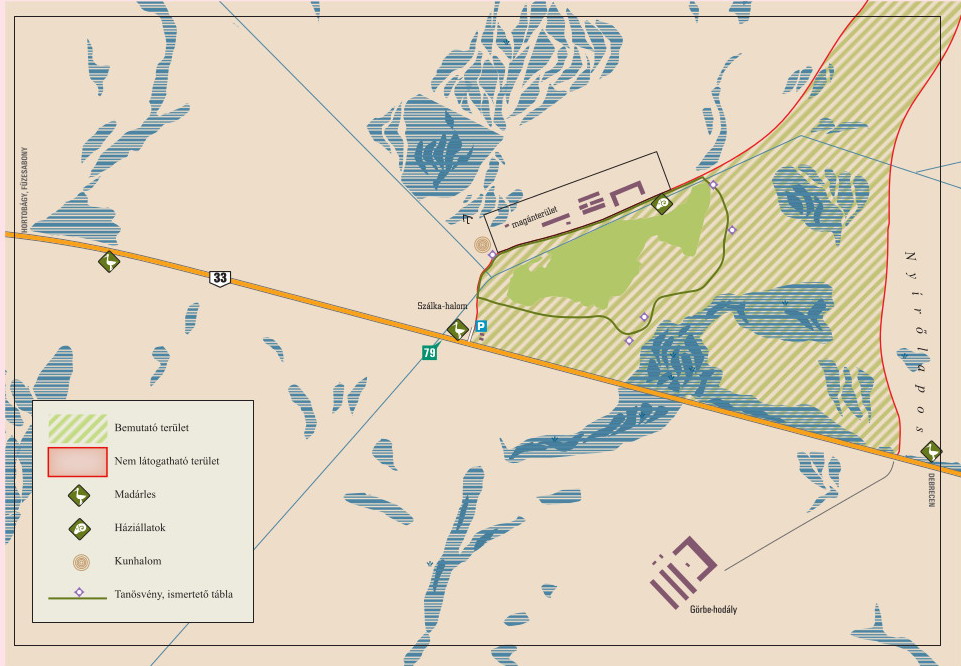Nature Trail of Szálkahalom burial mounds
|
Location and accessibility: |
By car: along the main road 33 at 79 kilometer stone. There is a parking place for cars. Starting point GPS: 47°34'30.85"N; 21°14'35.93"E The nature trail can be visited by foot. There are no difficult parts, anyone can walk along conveniently. |
|
Entrance: |
From the carpark |
|
Sights & Facilities: |
The nature trail euipped with station number boards begins at the watching tower next to the parking places, and the first station is at Szálkahalom mounds. The trip is appr. 1 km long and can be reached in a 45-minute walk. The trail path runs on the right (southern) side of the forest. At the east side of the forest we find first dry saline puszta plant communities, and then the area of wet saline biotops (marshland, swamp), along the main road 33. |
Szálkahalom nature trail shows the typical microrelief forms and important plant communities of the Hortobágy steppes. The starting station, so called Szálkahalom got his name from its burial mound. These type of mounds were built by nomadic people 5 thousand years ago all over in the Eastern European Plain and Hungary. These were used for cultic and burial purposes and served as guarding spots.
This kurgán called Szálkahalom is 98 m. It was a former boundary sign between Debrecen and Balmazújváros. The ownership of it was often debated by the local leaders of the two cities. In 1731 both cities built wayside inns next to the kurgan but they failed and were shut soon.
Excursion around the Wind-screen Forest of Szálkahalom
Vegetation
Walking along the trail we can find all the plant communities typical for the alkaline grasslands of the Hortobágy. Patches of loess-plant communities can be found on the burial mound and on elevated areas created by old rivers and streams flowing here long ago. The most important loess-plant species here are the Phlomis, Clary sp, Hair-like Feather-grass, Agropyron pectinatum, Thalictrum minus.
With decreasing humus content of the soil, loess grasslands are replaced by Achilleo-Festucetum grasslands, where Achillea setacea and Festuca pseudovina are the dominant species.
On poor quality soils Artemisio-Festucetum grasslands flourish with Artemisia maritima and Festuca pseudovina as the most characteristic plant species
There are two types of plant communities that can survive on barren salty soil patches. Their existence depend on different extent of water-cover during spring. In wet patches Puccinellietum limosae dominates, while Camphorosmetum annuae lives on drier surfaces. In deeper, wetter depressions one can often find a special community called Pholiuro-Plantaginetum, with Pholiurus pannonicus and Plantago tenuiflora as dominating species.
In the deepest areas there is marsh vegetation. Open-water surfaces of marshy meadows transform into reed- and catstail bed followed by salty marsh communities like Bolboschoeno-Phragmitetum and Bolboschoenetum maritimi. In wet areas surrounding marshes Agrostio-Beckmannietum community grows on poor quality soil, while places with better quality soil are inhabited by Agrostio-Alopecuretum.
Wildlife
The most common mammal of the loess soil patches is the European Souslik being the most important prey of some raptors like Saker Falcon, Imperial Eagle and Long-legged Buzzard. It is almost the only prey of steppe Polecats, too.
Near the mound, in a Locust-tree plantation Red-Footed Falcon and Long-Eared Owl nest occupying abandoned nest of Rooks. Avifauna of marshes is characterised by Lapwings, Redshanks, Black-tailed Godwits nesting on the shore and Spotted Crakes and Common Snipes nesting among the tussocks. The most common passerine of alkaline grasslands of the Hortobágy is the Skylark.
In autumn ten-thousands of cranes, geese and ducks migrate over the Hortobágy. In October we can easily watch them near and above the demonstration trail. Winter landscape is characterised by flocks of Snow Buntings, Lapland Buntings and Twites and White-tailed Eagles hovering above the horizont.
Walking along the trail one can meet some old Hungarian breed of domesticated animals managing alkaline grasslands.

Rules and useful advice for visiting the nature trails:
- Visiting Rules apply to all areas maintained by the Hortobágy National Park Directorate.
- The nature trail can be visited in possession of a valid (daily, weekly, annual) entrance card.
- The nature trail can be visited on foot. The using of the road depends on the weather.
- You can visit the trail on your own.
- Please dress according to the weather conditions. In the summer, temperatures can reach 40°C (104 °F), therefore please take enough drinking water with you.
- Toilets are not available along the trail.
- Please keep quiet, don’t disturb the natural tranquility of the area. Please don’t collect anything on the trail. Please take your litter back to the trash cans at the starting point.
The entrance card is available:
in the HNP Látogatóközpont in Hortobágy village (on mondays is closed)
in the Hortobágy Info building in Hortobágy village
kiosk (0-24) next to Hortobágy Info building
online















